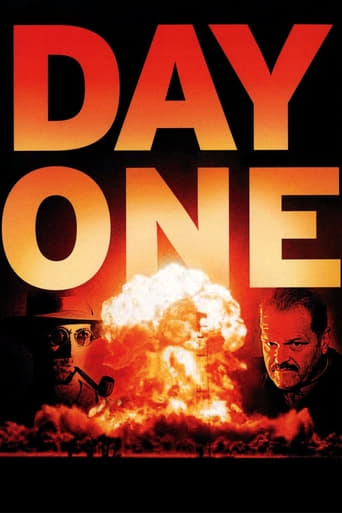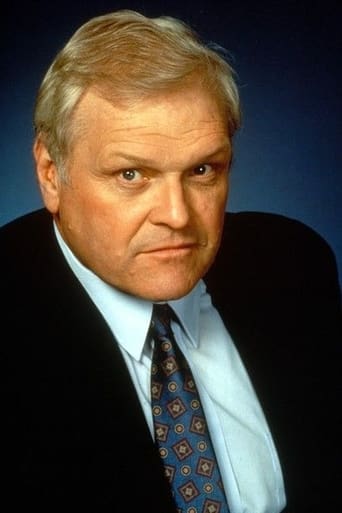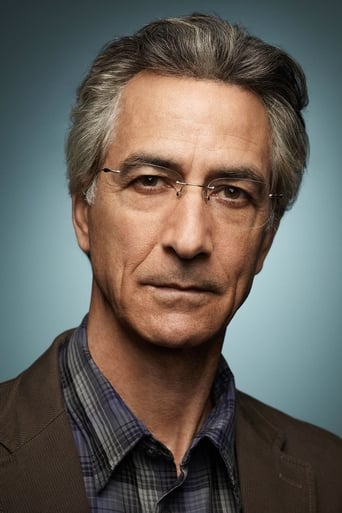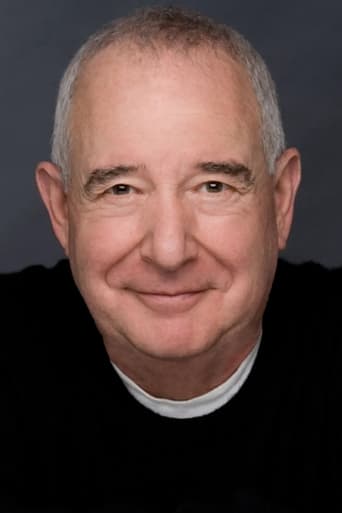

Day One (1989)
Hungarian physicist Leo Szilard leaves Europe, eventually arriving in the United States. With the help of Einstein, he persuades the government to build an atomic bomb. The project is given to no-nonsense Gen. Leslie Groves who selects physicist J. Robert Oppenheimer to head the Los Alamos Laboratory in New Mexico, where the bomb is built. As World War II draws to a close, Szilard has second thoughts about atomic weapons, and policy makers debate how and when to use the bomb.
Watch Trailer
Cast


Reviews
An Exercise In Nonsense
Although I seem to have had higher expectations than I thought, the movie is super entertaining.
A great movie, one of the best of this year. There was a bit of confusion at one point in the plot, but nothing serious.
There are moments in this movie where the great movie it could've been peek out... They're fleeting, here, but they're worth savoring, and they happen often enough to make it worth your while.
Brian Dennehy's Commanding Performance as Brig. Gen Leslie Groves drives this TV-Docudrama about "The Manhattan Project", the Scientific/Militaristic Collaboration to Design and Build the First Atomic Bomb.But Producing the "Super Weapon" opens up a "Pandora's Box" of Conflicting Philosophies and Strategic Questions that Human Beings were Forced to Answer, and Answer Quickly.History is Played Out quite Accurately, or as Accurate as something like a TV-Movie is Capable. It's an Astonishingly Detailed Account of the much Talked About Event."The Manhattan Project, Los Alamos, Oak Ridge, Trinity, Fat Man & Little Boy, Oppenheimer, Hiroshima, Nagasaki, Fall Out", and other Terms enters and remains in the Lexicon of Nervous Language to this Day. This is a good Dramatization. David Strathairn is Excellent as Robert J. Oppenheimer, "Oppie", to His Friends and Colleagues. He is more of a Complex Person than Groves and it wasn't as Easy to Flesh Out, but is given His Due and enough Screen Time to be a Fair Account of the Man.Overall, the Movie is a Must Watch for Historians and for Anyone Interested in War Room and Laboratory Intrigue where America's "Hawks and Doves" Mated and the "Love Child" and its Offspring are Still Alive and the Biography is Not Yet Complete.
I found this quite a disappointment after seeing other films. Many thoughts are introduced but not explained. A very thin story line which seems to have wandering parts. It appears to have been very darkly (lighting) shot, especially among the army uniforms to try to conceal that correct military jackets and other apparel was not sought out. The central character of any film in the atomic development is Dr. Oppenheimer and he seems to be reduced to a pipe smoking poor choice of a character instead of the commanding presence he was and of the many contributions he took part in, in the scientific equations. I thought the choice of portrayals of principals such as David Ogden Stires as President Roosevelt was a great diminution of FDR's extremely important role. Many parts central to the story are only minimally touched upon. The building the sites at Hanford and Oak Ridge is not even explained. Plutonium is said to be existing in thin air instead of as a transuranic element produced by of bombardment by a radioactive source such as a form of uranium with neutrons. In all, I found this to be very poorly done, though perhaps understandable because it was meant for and likely had little television exposure. Buy another film available if you want to see ample storytelling with any degree of accuracy.
This is the best of the atomic-bomb movies, and unfortunately still only available in VHS. Dennehy's performance as General Groves and Strathairn (of Good Night and Good Luck) does an amazing job as Oppenheimer. The characterizations are not the usual Hollywood clichés of professional people and their behavior. Real scientists and generals do not stop to have melodramatic arguments with stilted language, as in "Fat Man and Little Boy".It is also just an excellent job of portraying the history and science, but still remains a gripping human drama. We see the origins of the project in Europe, getting Einstein to write to the president, the issue of Soviet spies and Germany's failed efforts are described accurately, and the technical issues in building the bomb are accurate and interesting.
Day One by far is the best and most accurate full-scope portrayal of the events and people who ushered in the then-fantastic dawn of nuclear warfare. Perhaps it is the best portrayal merely because it is the most accurate and wide context picture of the what happened behind the scenes from 1933 to 1945. I was 11 years old and a schoolchild in Chicago that early August day 1945 when the world learned of the nuclear explosion over Hiroshima, to be followed up by the relatively forgotten "afterthought" atomic bomb dropped on Nagasaki a few days later. Now, at 66, I can look back on 1933-1945 and the age of cold war-enhanced nuclear terror that followed it in some broader and clearer perspective.Day One is actually three sequential and somewhat overlapping stories. The first story could be labeled "the Nuclear Theoreticians and Dreamers". It is essentially the story of Leo Szilard, Enrico Fermi, Edward Teller and a few other academics, mostly European Jews who fled to the west as refugees from the Europe that Adolf Hitler was taking over and threatening. Their interest was essentially a nuclear weapon that could be used to counter the one they expected Hitler to develop.Almost from the moment the United States government began taking a serious interest in their work, just prior to the Pearl Harbor attack in December 1941, commenced "the Project". With this commenced a series of major experiments in applied science and industrial engineering for purposes of creating the raw materials of atomic weapons -- Plutonium and Uranium 235 -- and for designing and building the actual bombs and trigger mechanisms needed to turn scientific theory into nuclear explosive reality. This succinctly describes the Manhattan Project, code name for the biggest and best kept secret in history, operated at a vast, hidden desert facility near Los Alamos, New Mexico under control of the brilliant Dr Robert Oppenheimer and the hard driving US General Leslie Groves.From about the time Harry S Truman succeeded the dead Franklin Roosevelt as US president in April 1945 -- three months before the day of Trinity -- codename for the first atomic bomb test in New Mexico in the early morning hours of July 16, 1945 -- the project came under full control of the civil and military leadership of the wartime United States: Truman himself, secretary of state James Byrnes, secretary of war Henry Stimson, chief of staff George C Marshall, Fleet Admiral William Leahy and a few others, formed into a committee to decide national policy for the use of the shortly expected super weapons. General Groves and Dr Oppenheimer were members of this select committee, and their suggestions drove the policy that committed the United States to actual use of the bombs against Japan, which still fought on after the death of Adolf Hitler and the complete destruction of National Socialist Germany. But the true controlling power was in the hands of Byrnes and Truman himself. They were determined to end the bloody war against Japan -- and gain diplomatic mastery over Josef Stalin's Soviet Union -- through use of the most overwhelming weapons in human history. Besides, they argued, how could the Truman administration justify to the United States Congress spending the then-princely sum of $2 billion and deploying scores of thousands of manpower, developing a weapon that we could never dare use against a real enemy -- at a time when there was one American combat casualty for every two Japanese on every island that this country had invaded over the past two years? The horror of it is that it is still a compelling argument even today, 55 years later. So, against the futile arguments of some of the early nuclear theoreticians, the ultimate weapons were used -- for the first and so far only times -- twice in one week in August 1945 and thereby instantly ended World War IIDay One is told in the remorselessly cold and nondramatic style of documentary history. The dialogue from the meetings presided over by Byrnes and Stimson was taken direct from the released historical records. The color film of the Trinity explosion in New Mexico was real, not re-created. The film of the flight of the Enola Gay, the B-29 bomber that released the Hiroshima bomb, was the authentic black and white film made during the flight. The voices over the plane's intercom -- "My God, what have we done?" -- are all real. The utter reality of it all has glued me to my seat and riveted my attention through three or more viewings.




